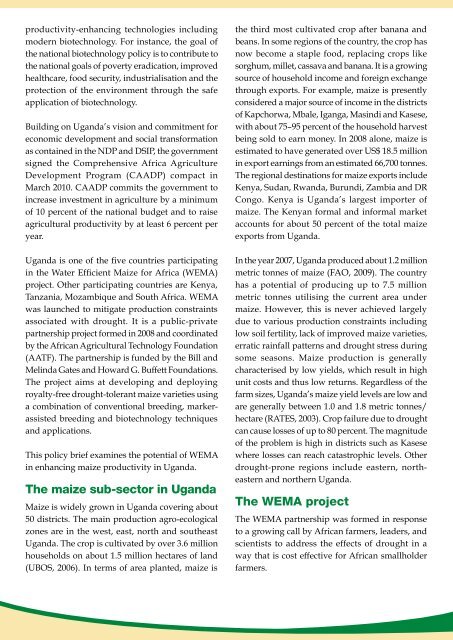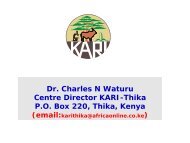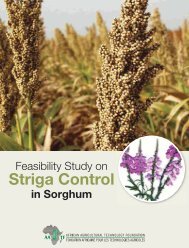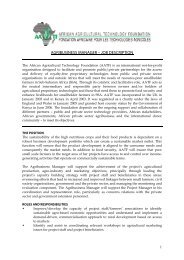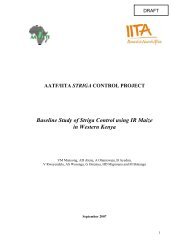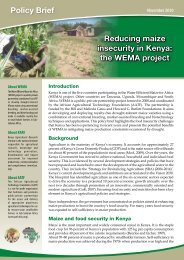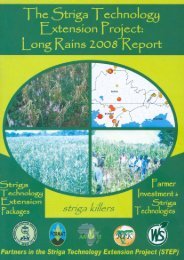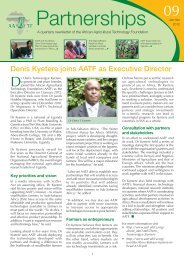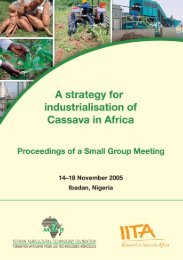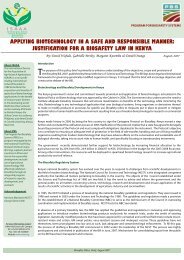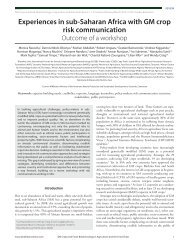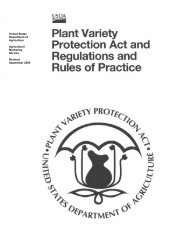Enhancing maize productivity in Uganda through the WEMA project
Enhancing maize productivity in Uganda through the WEMA project
Enhancing maize productivity in Uganda through the WEMA project
You also want an ePaper? Increase the reach of your titles
YUMPU automatically turns print PDFs into web optimized ePapers that Google loves.
<strong>productivity</strong>-enhanc<strong>in</strong>g technologies <strong>in</strong>clud<strong>in</strong>g<br />
modern biotechnology. For <strong>in</strong>stance, <strong>the</strong> goal of<br />
<strong>the</strong> national biotechnology policy is to contribute to<br />
<strong>the</strong> national goals of poverty eradication, improved<br />
healthcare, food security, <strong>in</strong>dustrialisation and <strong>the</strong><br />
protection of <strong>the</strong> environment <strong>through</strong> <strong>the</strong> safe<br />
application of biotechnology.<br />
Build<strong>in</strong>g on <strong>Uganda</strong>’s vision and commitment for<br />
economic development and social transformation<br />
as conta<strong>in</strong>ed <strong>in</strong> <strong>the</strong> NDP and DSIP, <strong>the</strong> government<br />
signed <strong>the</strong> Comprehensive Africa Agriculture<br />
Development Program (CAADP) compact <strong>in</strong><br />
March 2010. CAADP commits <strong>the</strong> government to<br />
<strong>in</strong>crease <strong>in</strong>vestment <strong>in</strong> agriculture by a m<strong>in</strong>imum<br />
of 10 percent of <strong>the</strong> national budget and to raise<br />
agricultural <strong>productivity</strong> by at least 6 percent per<br />
year.<br />
<strong>project</strong>. O<strong>the</strong>r participat<strong>in</strong>g countries are Kenya,<br />
Tanzania, Mozambique and South Africa. <strong>WEMA</strong><br />
was launched to mitigate production constra<strong>in</strong>ts<br />
associated with drought. It is a public-private<br />
partnership <strong>project</strong> formed <strong>in</strong> 2008 and coord<strong>in</strong>ated<br />
by <strong>the</strong> African Agricultural Technology Foundation<br />
(AATF). The partnership is funded by <strong>the</strong> Bill and<br />
Mel<strong>in</strong>da Gates and Howard G. Buffett Foundations.<br />
The <strong>project</strong> aims at develop<strong>in</strong>g and deploy<strong>in</strong>g<br />
royalty-free drought-tolerant <strong>maize</strong> varieties us<strong>in</strong>g<br />
a comb<strong>in</strong>ation of conventional breed<strong>in</strong>g, markerassisted<br />
breed<strong>in</strong>g and biotechnology techniques<br />
and applications.<br />
This policy brief exam<strong>in</strong>es <strong>the</strong> potential of <strong>WEMA</strong><br />
<strong>in</strong> enhanc<strong>in</strong>g <strong>maize</strong> <strong>productivity</strong> <strong>in</strong> <strong>Uganda</strong>.<br />
The <strong>maize</strong> sub-sector <strong>in</strong> <strong>Uganda</strong><br />
Maize is widely grown <strong>in</strong> <strong>Uganda</strong> cover<strong>in</strong>g about<br />
50 districts. The ma<strong>in</strong> production agro-ecological<br />
zones are <strong>in</strong> <strong>the</strong> west, east, north and sou<strong>the</strong>ast<br />
<strong>Uganda</strong>. The crop is cultivated by over 3.6 million<br />
households on about 1.5 million hectares of land<br />
(UBOS, 2006). In terms of area planted, <strong>maize</strong> is<br />
<strong>the</strong> third most cultivated crop after banana and<br />
beans. In some regions of <strong>the</strong> country, <strong>the</strong> crop has<br />
now become a staple food, replac<strong>in</strong>g crops like<br />
sorghum, millet, cassava and banana. It is a grow<strong>in</strong>g<br />
source of household <strong>in</strong>come and foreign exchange<br />
<strong>through</strong> exports. For example, <strong>maize</strong> is presently<br />
considered a major source of <strong>in</strong>come <strong>in</strong> <strong>the</strong> districts<br />
of Kapchorwa, Mbale, Iganga, Mas<strong>in</strong>di and Kasese,<br />
with about 75–95 percent of <strong>the</strong> household harvest<br />
be<strong>in</strong>g sold to earn money. In 2008 alone, <strong>maize</strong> is<br />
estimated to have generated over US$ 18.5 million<br />
<strong>in</strong> export earn<strong>in</strong>gs from an estimated 66,700 tonnes.<br />
The regional dest<strong>in</strong>ations for <strong>maize</strong> exports <strong>in</strong>clude<br />
Kenya, Sudan, Rwanda, Burundi, Zambia and DR<br />
Congo. Kenya is <strong>Uganda</strong>’s largest importer of<br />
<strong>maize</strong>. The Kenyan formal and <strong>in</strong>formal market<br />
accounts for about 50 percent of <strong>the</strong> total <strong>maize</strong><br />
exports from <strong>Uganda</strong>.<br />
In <strong>the</strong> year 2007, <strong>Uganda</strong> produced about 1.2 million<br />
metric tonnes of <strong>maize</strong> (FAO, 2009). The country<br />
has a potential of produc<strong>in</strong>g up to 7.5 million<br />
metric tonnes utilis<strong>in</strong>g <strong>the</strong> current area under<br />
<strong>maize</strong>. However, this is never achieved largely<br />
due to various production constra<strong>in</strong>ts <strong>in</strong>clud<strong>in</strong>g<br />
low soil fertility, lack of improved <strong>maize</strong> varieties,<br />
erratic ra<strong>in</strong>fall patterns and drought stress dur<strong>in</strong>g<br />
some seasons. Maize production is generally<br />
characterised by low yields, which result <strong>in</strong> high<br />
unit costs and thus low returns. Regardless of <strong>the</strong><br />
farm sizes, <strong>Uganda</strong>’s <strong>maize</strong> yield levels are low and<br />
are generally between 1.0 and 1.8 metric tonnes/<br />
hectare (RATES, 2003). Crop failure due to drought<br />
can cause losses of up to 80 percent. The magnitude<br />
of <strong>the</strong> problem is high <strong>in</strong> districts such as Kasese<br />
where losses can reach catastrophic levels. O<strong>the</strong>r<br />
drought-prone regions <strong>in</strong>clude eastern, nor<strong>the</strong>astern<br />
and nor<strong>the</strong>rn <strong>Uganda</strong>.<br />
The <strong>WEMA</strong> <strong>project</strong><br />
The <strong>WEMA</strong> partnership was formed <strong>in</strong> response<br />
to a grow<strong>in</strong>g call by African farmers, leaders, and<br />
scientists to address <strong>the</strong> effects of drought <strong>in</strong> a<br />
way that is cost effective for African smallholder<br />
farmers.


